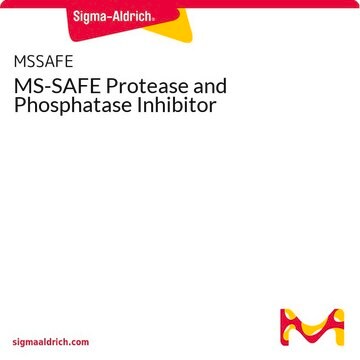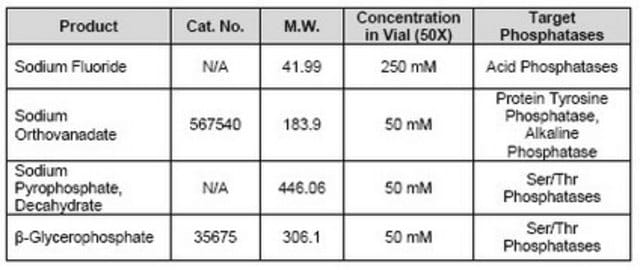PPC1010
Protease and Phosphatase Inhibitor Cocktail
DMSO solution, for the inhibition of serine, cysteine, acid proteases, aminopeptidase, serine/threonine protein phosphatases and L-isozymes of alkaline phosphatase
Sinonimo/i:
Protease and Phosphatase Inhibitor Mix, Protease and phosphatase inhibitor
About This Item
Prodotti consigliati
product name
Protease and Phosphatase Inhibitor Cocktail,
Forma fisica
DMSO solution
Livello qualitativo
Confezionamento
pkg of 1 ml, 5 ml ×
Condizioni di spedizione
wet ice
Temperatura di conservazione
−20°C
Descrizione generale
Applicazioni
- for cellular protein extraction
- to lyse purified CD4+ T cells
- to prepare protein extracts from placental tissues and cells
Nota sulla preparazione
Altre note
Avvertenze
Warning
Indicazioni di pericolo
Consigli di prudenza
Classi di pericolo
Eye Irrit. 2 - Skin Irrit. 2
Codice della classe di stoccaggio
10 - Combustible liquids
Classe di pericolosità dell'acqua (WGK)
WGK 2
Punto d’infiammabilità (°F)
188.6 °F
Punto d’infiammabilità (°C)
87 °C
Certificati d'analisi (COA)
Cerca il Certificati d'analisi (COA) digitando il numero di lotto/batch corrispondente. I numeri di lotto o di batch sono stampati sull'etichetta dei prodotti dopo la parola ‘Lotto’ o ‘Batch’.
Possiedi già questo prodotto?
I documenti relativi ai prodotti acquistati recentemente sono disponibili nell’Archivio dei documenti.
I clienti hanno visto anche
Contenuto correlato
Una panoramica sulle metodiche per la lisi cellulare e per l’estrazione delle proteine, tra cui solubilizzazione mediante detergente, lisi per congelamento-scongelamento, shock osmotico, sonicazione, lisi enzimatica e tecniche di disgregazione meccanica mediante omogenizzatori Dounce o Polytron o con mortaio e pestello.
Cell lysis and protein extraction methods overview various techniques, from detergent solubilization to mechanical disruption, supporting research needs.
Il team dei nostri ricercatori vanta grande esperienza in tutte le aree della ricerca quali Life Science, scienza dei materiali, sintesi chimica, cromatografia, discipline analitiche, ecc..
Contatta l'Assistenza Tecnica.
















